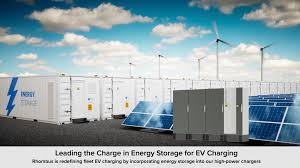
Rhombus Energy Solutions announced the certification of its high-power 60 kilowatt (kW) AC to DC Power Conditioning System (PCS) charger unit to Underwriter Laboratories UL 1741 & 1741-SA standards. UL 1741 is UL’s Standard for Inverters, Converters, Controllers and Interconnection System Equipment for Use With Distributed Energy Resources. This standard defines the design and testing requirements to certify that bidirectional, grid tied, “smart” inverters and electric vehicle (EV) chargers can be safely used to support the distributed generation (DG) grid services and applications. Utilities in the United States and worldwide are increasingly interested in opportunities to cost effectively add energy storage to support increasing levels of intermittent renewable energy sources. This certification builds on Rhombus’ existing UL 2202 (Standard for Electric Vehicle Charging Systems) certification for the Rhombus 60kW high-power charger PCS.
The new charging stations will come equipped with a cloud-based software platform from Nuvve Corporation, the global leader in vehicle-to-grid (V2G) technology. V2G is an important emerging technology that is rapidly becoming a requirement for EV fleet charging infrastructure. The combination of Rhombus’ bidirectional high-power charging technology and Nuvve’s software platform enables EV owners and operators to store, discharge and monetize the energy stored in the EV batteries, and then offer that energy to utilities for various grid support services. These services may include peak shaving, load shifting, voltage / frequency regulation or power factor correction. Achieving UL 1741-SA certification requires both specialized engineering and testing expertise. Rhombus Energy Solutions is one of only a few companies that have achieved this certification targeting V2G applications.
“Bidirectional EV charging offers a win-win opportunity for both EV owners and the utilities they are connected to,” said Rick Sander, CEO of Rhombus Energy Solutions. “EV fleet operators can be compensated for supporting the grid when their vehicle is not on the road, and utilities benefit from tapping into heavily under-utilized energy storage contained in the growing number of EVs being manufactured. The bidirectional V2G capability of our chargers, combined with Nuvve’s software platform, enables EV fleet operators to manage and reduce their energy costs in a variety of new ways.”
Rhombus bidirectional 60kW chargers are designed to be utilized with EV fleets and by charging network operators. The certification of this charger for V2G operation provides fleet operators with new tools to reduce their energy costs by offering the ability to put power and energy back on the grid when utilities need it most, and recharging off peak when demand and prices fall. The combination of V2G with the market-leading reliability of Rhombus’ high-power AC-DC chargers assures EV OEMs, charging network operators and EV fleet operators that they can procure chargers today that will meet tomorrow’s needs.
“Renewable energy sources such as wind and solar are variable by nature and need a way to be stored and then discharged so that they can be leveraged during peak demand hours or whenever the energy is needed,” said Gregory Poilasne, CEO and Chairman at Nuvve. “Our platform, combined with the charging hardware from Rhombus, bridges the gap between renewable energy generation and consumer needs. As a Rhombus Energy Solutions partner, Nuvve Corporation enthusiastically welcomes the recent UL 1741SA certification of Rhombus’ 60kW PCS as an essential building block in V2G commercialization.”
The certification of the Rhombus 60kW PCS to UL 1741SA, in addition to its UL 2202 (Standard for Electric Vehicle Charging Systems) certification, means that the 60kW PCS can now be utilized in V2G applications. Rhombus will also extend this certification in the near future by certifying its PCS under UL 9741 with dispensers from Rhombus and other industry partners. These combinations of V2G solutions will offer a means for EV fleet operators to utilize their vehicles as a source of energy storage, allowing power to be put back onto the grid or to be used to power buildings in a “behind the meter” approach. This can result in significant energy cost savings for fleet operators who utilize EVs in their fleets.
“At Rhombus, we have designed our chargers specifically to meet the needs of fleet EV operators,” said Joseph Gottlieb, CTO of Rhombus Energy Solutions. “While achieving UL 1741SA certification is probably one of the greatest engineering and testing challenges in the EV charging market, it is one that we enthusiastically undertook. It allows us to provide our customers with charging solutions that meet their needs today and tomorrow.”
Rhombus has fielded hundreds of high-power, bidirectional, high-reliability fleet EV charging systems and inverters for energy storage and PV solar-based microgrid, for customers in a variety of demanding operational environments. Adding V2G capabilities to these chargers through its recent certification under UL 1741SA assures fleet EV operators that their charging infrastructure will meet the EV charging needs of both today and tomorrow. V2G also enables both significant energy cost savings for EV fleet operators, and the ability to provide power to critical infrastructure during power emergencies if needed.
About Rhombus Energy Solutions
Rhombus develops and manufactures next-generation bi-directional electric vehicle charging infrastructure, high-efficiency power conversion systems and energy management system (EMS) software for vehicle-to-grid (V2G) capable electric vehicle fleet charging, energy storage and microgrid applications. The high reliability of our solutions is the result of decades of experience developing high-power systems for a variety of applications and deployment scenarios, including UL-1741SA system-to-grid solutions. For more information, please visit http://www.RhombusEnergy.com









More Stories
Dürr and GROB concept battery factory uses 50% less production space
DuPont materials science advances next generation of EV batteries at The Battery Show
Cybord warns of dangers of the stability illusion